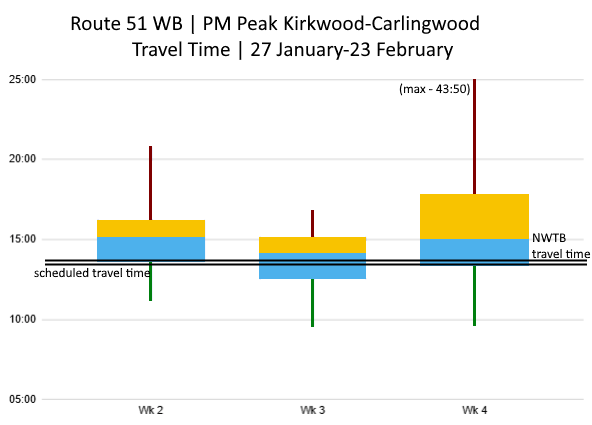This article presents a "snapshot" of service on Route 51 between the 27th of January and 23rd of February in 2025. Data from Transsee.
Cancellations
Over the period of four weeks, the route saw an average of 9.6% cancellations. Eastbound (towards Tunney's Pasture) cancellations were 8.4%; westbound (towards Lincoln Fields/Britannia) cancellations were 10.6%.
Headways
Apart from week four, which saw the aftermath of the giant snowfall over the few days prior, the route shows the usual patterns: large deviations in the AM, falling somewhat in the midday. It then rises to its peak in the PM peak, along with a higher rate of cancellations, before falling again in the evening.
On Time Performance
On time performance on Route 51 varies by time of day and direction.
Eastbound on time performance is poor across the route. It also shows signs of inadequate travel time, especially eastbound.
In the AM peak, there are significant delays on the Britannia branch, but limited delays on the short turns to Lincoln Fields.
In the AM peak, there are significant delays on the Britannia branch, but limited delays on the short turns to Lincoln Fields.
In the PM peak, both branches see significant delays, coming from both interlining and a poorly written schedule which propagates delays (especially on the Britannia branch).
On time performance is not much better going westbound, and it also shows signs of inadequate scheduled travel time.
Weekend performance is not good either. Apart from the eastbound short turn, they all show significant evidence of delay propagation along the route, in addition to interlining delays (153 interference?)
As always, string diagrams can show more granular problems than weekly or monthly averages. The charts below show Thursday and Saturday.
- Richmond is a problem all-day in the eastbound. Either the route could use increased runtimes, or it could be removed from Richmond and run down Byron instead like its pre-2011 alignment.
- Carlingwood is a problem all day.
- Travel times are slow on certain trips approaching and departing Lincoln Fields, including Carling.
- Blending of the two branches is surprisingly healthy.
Travel Time
Note that these charts only contain weeks 2-4.
Between Carlingwood and Kirkwood/Clare, travel times, while variable, are not out of control - this route's nature as a residential one should, in theory, insulate it from unreliability. Yet OC Transpo proposes to reduce the already inadequate travel time even further, presumably to save money, and in the peak direction as well.
When Amilcar says that the schedules will be more suited to traffic patterns after New Ways to Bus, I do not think she is telling the full truth.
Bafflingly, New Ways to Bus will increase runtimes in the counterpeak, but not the peak direction, and this is despite both directions seeing a large deficit in their scheduled runtimes.
Like in the AM, travel times are mostly under control - ensuring reliability on this route is a matter of scheduling enough runtime to make it. For the most part, the EB direction in the counterpeak makes that cut.
Travel times are under control. As mentioned, the route's nature as a residential line insulates it from the worst of the traffic than can affect mainlines like the 39 and 88. New Ways to Bus is a moderate improvement for this traffic direction.

The runtimes are the least reliable in this period, but they are still not bad, compared to other routes operated by OC Transpo. The effect of the snowstorms are evident in the week four data, which show a much greater top quartile.
New Ways to Bus is, at the very least, an improvement in runtimes during this period.
Thoughts
Route 51 is a great test for how OC Transpo manages reliability. The usual excuses about traffic and long route lengths do not apply here, as the route is fairly short and runs mostly on residential roads with little traffic, and for the most part, the travel time data bears that out. The travel time is relatively flat, without the crazy variation seen on many routes, and yet, reliability is as bad as ever.
If Route 51 can teach us anything, it's that the operations - runtime, interlining, and so on - have just a great of influence on reliability as the usual reasons cited by both the transit agency and urbanists. And with just one look at Route 51, we can see that City Council is not very interested in this issue, and that OC Transpo does not care about these issues that can improve the transit rider's experience.
This is greatly disappointing. None of what I am saying is a great mystery, and it does not require a genius or an enormous budget to figure out (I write these snapshots with a budget of exactly $0). The impression given by the happenings at 1500 St. Laurent and 110 Laurier is that nobody is minding the store, and riders suffer.
Next up (probably), a look at the recent report on OC Transpo's training program for operators on Lines 2 and 4. That should be fun. Keep an eye out, and stay safe out there.




































No comments:
Post a Comment